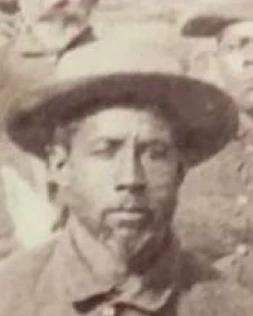Last updated: March 29, 2024
Person
John Ward

Public Domain
John Ward also known as John Warrior was born in 1847 in Arkansas. His parents were both Black Seminoles. It is believed he was born while his parents were forcibly moved west.
During the U.S. government’s Indian removal efforts, from 1830 to 1850, many tribes including Seminole people, were forcibly moved West to Indian Territory, modern-day Oklahoma. The Black Seminoles endured starvation and disenfranchisement as did other native peoples during that time. Upon arrival in Indian Territory, they remained vulnerable to kidnapping and re-enslavement.
In 1850, this threat became too much for the Black Seminole Indians, including the Ward family. A group led by John Horse and Coacoochee, known as Wild Cat, left Indian Territory and traveled to Mexico, where they could live without fear of re-enslavement. The Mexican government received them warmly and welcomed their help in fighting against Apache and Comanche raiding parties that crossed into Mexico. They also helped fend off bandits and slave raiders attempting to annex parts of Mexico to create a pro-slavery state.
After 20 years in Mexico, the Black Seminoles were interested in returning to the United States. They hoped to reclaim their land rights set out in original treaties at the time of Indian Removal. Major Zenas R. Bliss of the Twenty-Fifth Infantry encouraged the Black Seminoles to emigrate back to the United States and offered them positions as scouts.
The first group of Black Seminoles including John Ward enlisted at Fort Duncan on August 16, 1870. They were led by John Kibbetts. He was appointed sergeant upon enlistment. He gave his name as Sittee Tustenuggee (pronounced as “Sit-tee-tas-to-nachy”), or Snake Warrior when he enlisted.
The scouts quickly adapted to their new environment. Major Bliss said they were “excellent hunters, and trailers, and brave scouts…splendid fighters.” Bliss and other officers were more than happy to give the scouts and their families a place to live in exchange for their skills on the frontier.
On April 25, 1875, Lieutenant John Lapham Bullis was on patrol with Black Seminole Scouts Sergeant John Ward, Pompey Factor, and Isaac Payne when they came across a fresh trail of about 75 horses. The men followed the trail until they came to a place on the Pecos River known as Eagle’s Nest Crossing. Near the crossing the men spotted a group of about 25 Comanche. Bullis could not resist the opportunity; he and Ward, Factor, and Payne dismounted and started to attack the Comanche. After about 45 minutes the Comanche, using repeating Winchester rifles, were able to push back Bullis and the scouts.
As Ward, Factor, and Payne escaped, they saw that Bullis was not able to get on his frightened horse. The men knew Bullis would die if he was left behind. Ward rode to Bullis’s rescue while Factor and Payne provided covering fire. All four men then rode 56 miles back to Fort Clark, Texas, to safety.
Shortly after returning to Fort Clark, Bullis recommended all three men for the Medal of Honor. Ward was presented with the Medal of Honor on May 28, 1875. His Medal of Honor citation read, “With three other men, he participated in a charge against 25 hostiles while on a scouting patrol.”
Ward remained with the scouts until 1895, when severe rheumatism prevented him from being able to mount his horse. He received a pension each month until his death on May 24, 1911; his widow got a monthly check until her death in 1926. John Ward was buried at the Seminole Indian Scout Cemetery in Brackettville, Texas.
